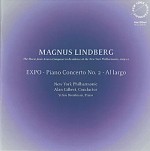Column Name
Title
Magnus Lindberg: EXPO, Piano Concerto No. 2, Al Largo. New York Philharmonic, Alan Gilbert, conductor; Yefim Bronfman, piano. (Da Capo 8.226076)
Body
In the fall of 2009, Finnish composer Magnus Lindberg began a two-year term as the New York Philharmonic’s composer-in-residence, a position initiated by Alan Gilbert (Pre-College ’85; M.M. ’94), the Phil’s music director and Juilliard’s director of conducting and orchestral studies. The collaboration was so successful that it was extended for a third year. This disc features the commissions that Lindberg completed during his tenure, starting with EXPO (2009), an extravagantly scored showpiece for large orchestra with imposing textures that Gilbert weaves with utter confidence. Fluid lines dart about, separate and converge, reaching towering climaxes during the work’s 10 minutes.
In the Piano Concerto No. 2 (2011-12), Yefim Bronfman (’81) plunges into the sweeping first movement with its Impressionistic sections that make way for ominous marches. In the majestic second movement, filled with refulgent brass, the pianist alternates between introspection and explosive color. The tarantella-like passages from the opening reappear in the final movement, with Bronfman giving heroic effort to Lindberg’s demanding piano fireworks. Huge chords herald the concerto’s end as the orchestra sweeps in for a brilliant conclusion. Throughout, Gilbert elicits a powerful response from the players; the chemistry is palpable.
Exultant brass and scurrying strings open Al largo (2009-10), and listeners will continue to marvel at Lindberg’s orchestration skills, whose penchant for lushness and detail are reminiscent of Ravel. Gilbert brings clarity and suppleness to what might turn impenetrable in other hands. His sense of urgency, coupled with the expert response from the orchestra—the versatile percussion section in particular—makes the score pulse with life.
The glowing purple cover image is by British artist Anish Kapoor; Lawrence Rock did the engineering honors, capturing the three works at live performances in Avery Fisher Hall from 2009 through 2012.
Elgar: Cello Concerto. Indianapolis Symphony Orchestra, Krzysztof Urbanski, conductor; Zuill Bailey, cello. (Telarc 34030-02)
 Some musicians can seduce by sheer tone alone, and Zuill Bailey (M.M. ’96) is one, making his 1693 Matteo Gofriller cello sing like a stringed equivalent of the great tenor Fritz Wunderlich. Working with Krzysztof Urbanski and the Indianapolis Symphony Orchestra, Bailey offers a beautifully phrased reading of Elgar’s ever-popular Cello Concerto. In the opening movement, Bailey’s tone underpins the richly melodic main theme with gusto, while Urbanski and the orchestra provide sensitive, sometimes understated accompaniment.
Some musicians can seduce by sheer tone alone, and Zuill Bailey (M.M. ’96) is one, making his 1693 Matteo Gofriller cello sing like a stringed equivalent of the great tenor Fritz Wunderlich. Working with Krzysztof Urbanski and the Indianapolis Symphony Orchestra, Bailey offers a beautifully phrased reading of Elgar’s ever-popular Cello Concerto. In the opening movement, Bailey’s tone underpins the richly melodic main theme with gusto, while Urbanski and the orchestra provide sensitive, sometimes understated accompaniment.
The skittering second movement shows Bailey’s precise articulation against an often-subdued orchestral fabric. Then comes the slow movement, which the cellist treats as if cradling a precious object. One of Elgar’s loveliest melodies—marked by some stirring pianissimos—pours out from Bailey’s instrument. In the final movement, in which Elgar revisits themes from the previous ones, Urbanski and the musicians summon up both stateliness and ardor. The audience is impressively quiet; only when the applause breaks out are you aware that the recording was made live (by engineer Michael Bishop, working in the orchestra’s home, the Hilbert Circle Theater).
Three selections from Smetana’s sprawling tone poem Ma Vlast complete the disc, starting with “Vysehrad” (“The High Castle”). Urbanski coaxes a rich sound from the Indianapolis players, who give the composer’s folk melodies fine musicianship and a warm congeniality. The horns lead the way with strong, focused tone. Flutes introduce the nostalgic “Vitava” (“The Moldau,” probably Smetana’s most-loved piece), which shows off the orchestra’s strings, before the vivacious “Sarka” ends the program on a bristling, festive note. And judging from the audience’s whooping reaction, being there in person must have been fun, too.





